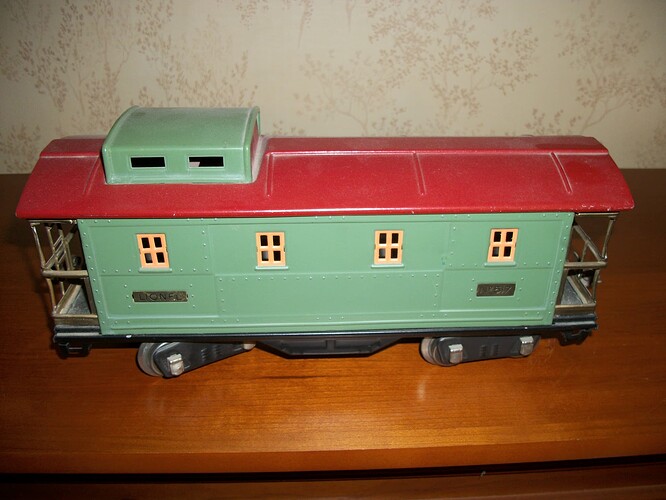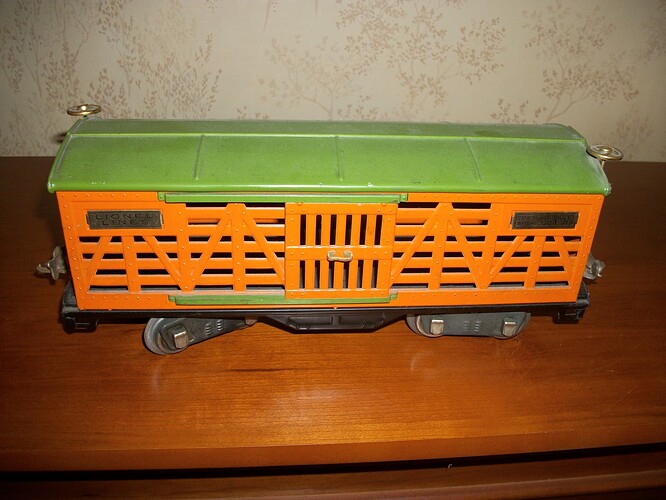You knew it had to happen, right? We have Flyer and we have IVES, so we need Lionel.
Let’s kick off with a #10E passenger set in gray and maroon. Here’s an over-all pic–forgive the staggering of the cars, but our mantel just isn’t long enough.
Here’s the loco. It sports a set of older replacement wheels, solid brass (which add to the already considerable weight).
Next is the 332 Baggage/Mail Car.
Next is the 339 Pullman.
Finally, the 341 Observation.
You’ll notice that this pair of small cars has doubled windows rather than single ones. In this case, the marbled transom strips have pulled away from the sides in the 339 and disappeared completely from the 341.
Here’s a pic of the set drifting off the bridge to come into the city on this past year’s Christmas layout.
An overhead view of the same scene. Yes, the train is stopped: my camera has very little capability to make a moving object clear.
Though Lionel is my third favorite among prewar SG, that;s sort of like saying that Cookie Dough is my third favorite ice cream: “third” still means good stuff!
5 Likes
palallin,
I have only collected a small amount of Lionel, but I wanted to help get this thread started.
Enjoying the World’s Greatest Hobby
Northwoods Flyer (?)
6 Likes
Thanks for the assist!
That’s a good looking engine. I think some of the prewar die-cast engines actually look better than their postwar descendants.
I have more Lionel to share, but I need to do some more photography.
Here’s a candid shot of a manifest freight on the Christmas layout passing the farm in the countryside heading toward the city to deliver the goods.
I’ll start posting pics of this freight along with the buildings and accessories I’ve managed to put together as I can get them down for their portraits 
6 Likes
Before we get to the freight train, we must remember that a pike which boasts of 4 powerful electric motors (the technical term for electrically powered locomotives) needs a great deal of electricity. So, we have to have a generating and distribution system. Let’s begin with the #436 Powerhouse and a half dozen #60 Telegraph or Power Poles.
Here’s a shot of the other side of the Powerhouse. The Powerhouse actually holds one of the medium-sized prewar transformers, and the skylight comes off so the operator can adjust the voltage.
And here’s a shot of one of the
#60 Poles. This one is in middling condition: one or two are worse; one or two are better.
Now we need the
#440 Power distribution Panel and Control Board.
I regret that my camera’s flash washes out the gauge dials and the ID plates. As you can see, the massive main distribution cables are still attached to the panel awaiting its next installation.
5 Likes
These are the cars that I run with my 224E
Enjoying the World’s Greatest Hobby
Northwoods Flyer Flyer
6 Likes
Those are in great shape!
1 Like
I’m not really a Pre-War guy BUT when I was at one of our club shows one of the exhibitors was selling a Lionel 259e complete with cars. All in almost like-new condition and the price was right and I swear every time I walked past it I heard a voice saying “Please take me home with you!”
So here it is!
And let me tell you, that little engine runs like a deer!
NOW after handling one and being VERY impressed I’ve got the urge to get one of THESE:
Uh-huh, a 226e. York’s coming, maybe I’ll get lucky?
8 Likes
I’,m glad you adopted that train, and I am sure it will continue running like a deer for a long time in gratitude 
Here’s a #92 Floodlight tower. The light assembly is an MTH repop because it only had one light when I got it, and I couldn’t find another original at the time. If I ever do, I’ll put the originals on it.
The height makes it hard to get a pic of without clutter

5 Likes
Now for the Manifest Freight I promised. This is not a set but rather an accumulation of one example of all the 500-series cars. Let’s be fair and start at the back rather than the front. Here’s the caboose.
This is a decent, older repaint. I am not sure about the green on it (the flash washes out the pic some), but it is in good shape and tracks well.
More to come!
6 Likes
It has so far! In fact I set up a table-top loop of track with a mini-Christmas tree for the club’s Christmas party and got quite a few compliments. I was told this was the first time someone had set up a little layout at any of the Christmas parties! Anyway, that little 259e was quite a hit!
1 Like
It looks a bit “minty” to me. The traditional color is a pea green but sometimes you can’t find good shaker can matches in home improvement stores so you go with what you like. I think I used that same shade (likely Rust-Oleum) on an O Gauge passenger car once with the view towards assembling an entire set in mint and forest green.
2 Likes
Working our way forward (as they sit on my selves) from the #517 caboose is the #513 Stock Car. On my RR, the stock cars are placed just in front of the cabooses so that the rear-end crew can keep an eye on the animals as the hoghead up front races to beat the 28-hour rule.
This is an earlier, pretty common version but in quite nice shape.
6 Likes
Of the three paint schemes: orange/green, green/orange and ivory/maroon, this one is my favorite. 

Just for everyone’s reference, here’s Henning’s color chart for Pre-War trains.
5 Likes
Thanks, Flintlock! That’s useful. I have used those paints, but it’s nice to have the reference here.
2 Likes
My customized #8 and her cars.
I used Tamiya paint but I don’t remember exactly what shades. If I had to guess I believe I used periwinkle on the body and dark navy on the roof. The frame was ok so it’s the way I got it. The rest was acid damaged. The loco has new wheels, headlights, couplers, flags and I replaced the tiny third rail service type pantograph it came with with a 402/408 style collapsible pantograph.
She has 2 matching #35 passenger cars (hard to call them coaches since they have only bench seats) and a #36 observation to run with when she isn’t hauling freight.
The observation is fitted with a Blue Comet drumhead but the set looks a bit more like American Flyer’s Wide Gauge Jeffersonian. That’s good old glass bottle Testor’s gold paint on the trim and the scalloped edge bit of blue celluloid was my idea.
The replacement celluloid as well as the reproduction oil labels came from Olsen’s along with the light fixtures and replacement couplers.
I use a bit of an unusual lighting arrangement for the cars. It’s based on the lighting kit Lionel produced in the early Standard Gauge era. There’s a terminal post on the back of the locomotive that is wired to the #8’s center rail rollers. Early era locos like the #33, 53, 42 etc. usually had this post mounted high on the rear hood. I used a vent in the shell. The cars get their positive current by being connected in series (actually in parallel) with quick connects on each car end. The negative connection is made through the metal shell, frame, trucks, axles and wheels.
The system works well and I didn’t have to find 100 series rollers and/or complete trucks for all 3 cars.
Unfortunately I can’t just couple up and go using this system. I used uninsulated quick disconnects so I have to connect the cars and wrap the plugs and sockets with electrical tape to keep them from shorting out the whole mess.
3 Likes
My favorite loco is 1666 which I believe is the same as the 224. And that series of passenger cars is my favorite, too. I have them in all three colors - green blue and brown
Working forward again, here is the #516 hopper.
This one shows play-wear but isn’t bent, rusted, or broken, and the mechanism works just fine. I know that postwar trains are lauded for their remote control, and modern trains hardly need us at all anymore, but I most often prefer the trains that the operator actually interacts with. Transformer control, manual switches, and turning the knob to dump the hopper’s load are fine for me.
4 Likes


































